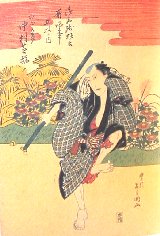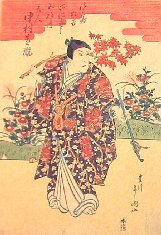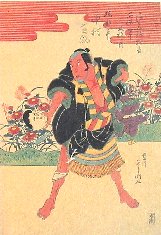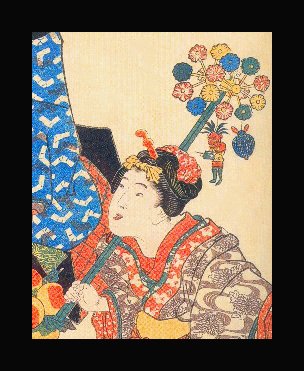
JAPANESE PRINTS
A MILLION QUESTIONS
TWO MILLION MYSTERIES
Ukiyo-e Prints浮世絵版画 |
|
formerly Port Townsend,
Washington now Kansas City, Missouri |
|
TOYOKAWA YOSHIKUNI 豊川よし国 fl. 1803-40? |
|
Actor: Nakamura Shikan II 中村芝翫 |
|
Role: Nursemaid Komori 子守 |
|
Play: Rangiku Tsuyu no Adamakura 乱菊露仂枕 |
|
Theater: Kado (in Osaka) 角 |
|
Size: 15 1/8" x 10" |
|
Date: 1827, 10th Month Bunsei 10 文政10 |
|
Signature: Toyokawa Yoshikuni ga |
|
Publisher: Honsei 夲清 |
|
This is one of five panels. Each shows Shikan II in a different role. |
|
Illustrated in Ikeda bunko, Kamigata yakusha-e shūsei, 1997, vol. 1, #399 |
|
There are copies of this print at the Museum of Fine Arts in Boston and at the Hankyu Culture Foundation. |
|
There is also a Toyokuni I from 1818 showing Nakamura Shikan II as a nursemaid holding a child and a pinwheel. This can be found at the Hankyu Culture Foundation, too. |
|
ORIGINALLY $210.00 NOW $147.00 SOLD! |
|
FUJIMA KAMESABURŌ AKA NAKAMURA FUJITARŌ AKA NAKAMURA TSURUTSUKE AKA NAKAMURA SHIKAN II AKA NAKAMURA UTAEMON IV |
|
|
| 1796? to 1852 |
 |
|
It is not uncommon for an actor to be known by various names throughout his career. In fact, it is the standard. Whether through adoption or advancement names are changed often - especially in the case of those who are particularly adept at their craft. Such is the case of Shikan II who is actually better known as Utaemon IV.
The son of the owner of a teahouse he started his career as a student of an uncle who was a dance master who adopted him in 1807. He worked as a choreographer or furitsuke (振り付け) until his move to Edo in 1811 when he entered the household of Utaemon III. At that time he took the name Nakamua Fujitarō. In Osaka in 1813 he changed it to Nakamura Tsurusuke. "In 1825 he became Shikan II while playing in Kyoto." By 1827 he was so successful that the government placed him under house arrest in Edo because of his lavish lifestyle. (This was not an isolated incident. Several other prominent actors and artists suffered the same fate at various times in their careers.)
In 1836 Shikan II was adopted by Utaemon III who changed his own name to Tamasuke. That allowed Shikan to become Utaemon IV. Although he was a large and imposing figure his abilities allowed him to play even female roles with aplomb. "Such versatility earned him the title kaneru yakushu...[兼ねる役者 - an 'all-around actor' or 'a man of a thousand faces'.]
Source and quotes from: New Kabuki Encyclopedia, Samuel Leiter, Greenwood Press, 1997. |
|
|
|
THE JAPANESE PINWHEEL KAZAGURUMA 風車 |
|
|
|
|
|
As a child I was fascinated by pinwheels. Don't know any that weren't. Some people never grow out of it. Even today I see them everywhere. When I ride my bike around Port Townsend it would be difficult to count the number of yards with them. And those are the only ones I can see. They're ubiquitous. |
|
|
|
Yoshikuni was as famous as a poet as he was an artist. According to Roger Keyes he "...was active as a print designer between 1813 and 1830... He may have been the son of Hakuensai Baikō, the late eighteenth century Osaka poet who was the proprietor of the publishing firm Shioya Saburobei. Yoshikuni may have begun his career in 1800 with a poetry anthology, and could have designed two or three prints that appeared with the signature Jukō in 1813. Although his career as a print designer ended around 1832, he seems to have continued his activity as a poet, leading the Jukōsha poetry group whose members designed actor prints."
Quoted from: The Theatrical World of Osaka Prints, by Roger Keyes and Keiko Mizushima, published by the Philadelphia Museum of Art, 1973, p. 252. |
|
|
|
In a section called 'The Rise of New Artists' Dean Schwaab noted that shortly after 1810 several significant artist all appeared on the scene in Osaka at about the same time. Yoshikuni (i.e., Jukō/Ashimaro) was among them. Jukōdō Yoshikuni published one print under the name Jukō in 1813. "He then moved to the Ashikuni school under the name Ashimaro. Only two compositions under this name are recorded..." Then he changed his name to Yoshikuni. In mid-1817 he collaborated on prints with Ashiyuki and Ashihisa. Later he worked with several other artists including Shibakuni, Ashiyuki, Kunihiro, Tamikuni, Hikokuni and Hokushū. From 1820 to 1832 he produced approximately 120 compositions. 61 of these represented Utaemon III.
Source and quotes from: Osaka Prints, by Dean J. Schwaab, published by Rizzoli, 1989, pp. 22 & 25-27. |




 HOME
HOME